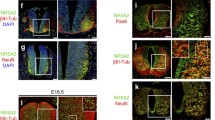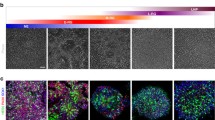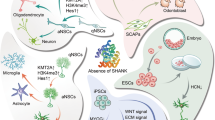Abstract
A better understanding of the control of stem cell maintenance and differentiation fate choice is fundamental to effectively realising the potential of human pluripotent stem cells in disease modelling, drug screening and cell therapy. Dlk1 is a Notch related transmembrane protein that has been reportedly expressed in several neurogenic regions in the developing brain. In this study, we investigated the ability of Dlk1 in modulating the maintenance and differentiation of human and mouse ESC-derived neural progenitors. We found that DLK1, either employed as an extrinsic factor, or via transgene expression, consistently promoted the generation of neurons in both the mouse and human ESC-derived neural progenitors. DLK1 exerts this function by inducing cell cycle exit of the progenitors, as evidenced by an increase in the number of young neurons retaining BrdU labelling and cells expressing the cycling inhibitor P57Kip2. DLK1 antagonised the cell proliferation activity of Notch ligands Delta 1 and Jagged and inhibited Hes1-mediated Notch signaling as demonstrated by a luciferase reporter assay. Interestingly, we found that DLK1 promotes the neurogenic potential of human neural progenitor cells via suppression of Smad activation when they are challenged with BMP. Together, our data demonstrate for the first time a regulatory role for DLK1 in human and mouse neural progenitor differentiation and establish an interaction between DLK1 and Hes1-mediated Notch signaling in these cells. Furthermore, this study identifies DLK1 as a novel modulator of BMP/Smad signalling.





Similar content being viewed by others
References
Bachmann, E., Krogh, T. N., Hojrup, P., Skjodt, K., & Teisner, B. (1996). Mouse fetal antigen 1 (mFA1), the circulating gene product of mdlk, pref-1 and SCP-1: isolation, characterization and biology. Journal of Reproduction and Fertility, 107, 279–285.
Baladron, V., Ruiz-Hidalgo, M. J., Nueda, M. L., Diaz-Guerra, M. J., Garcia-Ramirez, J. J., Bonvini, E., et al. (2005). dlk acts as a negative regulator of Notch1 activation through interactions with specific EGF-like repeats. Experimental Cell Research, 303, 343–359.
Bauer, M., Szulc, J., Meyer, M., Jensen, C. H., Terki, T. A., Meixner, A., et al. (2008). Delta-like 1 participates in the specification of ventral midbrain progenitor derived dopaminergic neurons. Journal of Neurochemistry, 104, 1101–1115.
Bolos, V., Grego-Bessa, J., & de la Pompa, J. L. (2007). Notch signaling in development and cancer. Endocrine Reviews, 28, 339–363.
Bonaguidi, M. A., McGuire, T., Hu, M., Kan, L., Samanta, J., & Kessler, J. A. (2005). LIF and BMP signaling generate separate and discrete types of GFAP-expressing cells. Development, 132, 5503–5514.
Borghese, L., Dolezalova, D., Opitz, T., Haupt, S., Leinhaas, A., Steinfarz, B., et al. (2010). Inhibition of notch signaling in human embryonic stem cell-derived neural stem cells delays G1/S phase transition and accelerates neuronal differentiation in vitro and in vivo. Stem Cells, 28, 955–964.
Chambers, S. M., Fasano, C. A., Papapetrou, E. P., Tomishima, M., Sadelain, M., & Studer, L. (2009). Highly efficient neural conversion of human ES and iPS cells by dual inhibition of SMAD signaling. Nature Biotechnology, 27, 275–280.
Chellappan, S. P., Giordano, A., & Fisher, P. B. (1998). Role of cyclin-dependent kinases and their inhibitors in cellular differentiation and development. Current Topics in Microbiology and Immunology, 227, 57–103.
Chiba, S. (2006). Notch signaling in stem cell systems. Stem Cells, 24, 2437–2447.
Christophersen, N. S., Gronborg, M., Petersen, T. N., Fjord-Larsen, L., Jorgensen, J. R., Juliusson, B., et al. (2007). Midbrain expression of Delta-like 1 homologue is regulated by GDNF and is associated with dopaminergic differentiation. Experimental Neurology, 204, 791–801.
da Rocha, S. T., Tevendale, M., Knowles, E., Takada, S., Watkins, M., & Ferguson-Smith, A. C. (2007). Restricted co-expression of Dlk1 and the reciprocally imprinted non-coding RNA, Gtl2: implications for cis-acting control. Developmental Biology, 306, 810–823.
Desai, A. R., & McConnell, S. K. (2000). Progressive restriction in fate potential by neural progenitors during cerebral cortical development. Development, 127, 2863–2872.
Elkabetz, Y., Panagiotakos, G., Al Shamy, G., Socci, N. D., Tabar, V., & Studer, L. (2008). Human ES cell-derived neural rosettes reveal a functionally distinct early neural stem cell stage. Genes & Development, 22, 152–165.
Gearhart, J. (1998). New potential for human embryonic stem cells. Science, 282, 1061–1062.
Gerrard, L., Rodgers, L., & Cui, W. (2005). Differentiation of human embryonic stem cells to neural lineages in adherent culture by blocking bone morphogenetic protein signaling. Stem Cells, 23, 1234–1241.
Goffredo, D., Conti, L., Di Febo, F., Biella, G., Tosoni, A., Vago, G., et al. (2008). Setting the conditions for efficient, robust and reproducible generation of functionally active neurons from adult subventricular zone-derived neural stem cells. Cell Death and Differentiation, 15, 1847–1856.
Gross, R. E., Mehler, M. F., Mabie, P. C., Zang, Z., Santschi, L., & Kessler, J. A. (1996). Bone morphogenetic proteins promote astroglial lineage commitment by mammalian subventricular zone progenitor cells. Neuron, 17, 595–606.
Ishibashi, M., Moriyoshi, K., Sasai, Y., Shiota, K., Nahanishi, S., & Kageyama, R. (1994). Persistent expression of helix-loop-helix factor HES-1 prevents mammalian neural differentiation in the central nervous system. The EMBO Journal, 13, 1799–1805.
Jacobs, F. M., van der Linden, A. J., Wang, Y., von Oerthel, L., Sul, H. S., Burbach, J. P., et al. (2009). Identification of Dlk1, Ptpru and Klhl1 as novel Nurr1 target genes in meso-diencephalic dopamine neurons. Development, 136, 2363–2373.
Jensen, C. H., Krogh, T. N., Hojrup, P., Clausen, P. P., Skjodt, K., Larsson, L. I., et al. (1994). Protein structure of fetal antigen 1 (FA1). A novel circulating human epidermal-growth-factor-like protein expressed in neuroendocrine tumors and its relation to the gene products of dlk and pG2. European Journal of Biochemistry, 225, 83–92.
Jensen, C. H., Meyer, M., Schroder, H. D., Kliem, A., Zimmer, J., & Teisner, B. (2001). Neurons in the monoaminergic nuclei of the rat and human central nervous system express FA1/dlk. Neuroreport, 12, 3959–3963.
Kaneta, M., Osawa, M., Sudo, K., Nakauchi, H., Farr, A. G., & Takahama, Y. (2000). A role for pref-1 and HES-1 in thymocyte development. The Journal of Immunology, 164, 256–264.
Kasai, M., Satoh, K., & Akiyama, T. (2005). Wnt signaling regulates the sequential onset of neurogenesis and gliogenesis via induction of BMPs. Genes to Cells, 10, 777–783.
Konstantoulas, C. J., Parmar, M., & Li, M. (2010). FoxP1 promotes midbrain identity in embryonic stem cell-derived dopamine neurons by regulating Pitx3. Journal of Neurochemistry, 113, 836–847.
Laborda, J., Sausville, E. A., Hoffman, T., & Notario, V. (1993). dlk, a putative mammalian homeotic gene differentially expressed in small cell lung carcinoma and neuroendocrine tumor cell line. The Journal of Biological Chemistry, 268, 3817–3820.
Mabie, P. C., Mehler, M. F., & Kessler, J. A. (1999). Multiple roles of bone morphogenetic protein signaling in the regulation of cortical cell number and phenotype. The Journal of Neuroscience, 19, 7077–7088.
Masamizu, Y., Ohtsuka, T., Takashima, Y., Nagahara, H., Takenaka, Y., Yoshikawa, K., et al. (2006). Real-time imaging of the somite segmentation clock: revelation of unstable oscillators in the individual presomitic mesoderm cells. Proceedings of the National Academy of Sciences of the United States of America, 103, 1313–1318.
Mathieu, C., Sii-Felice, K., Fouchet, P., Etienne, O., Haton, C., Mabondzo, A., et al. (2008). Endothelial cell-derived bone morphogenetic proteins control proliferation of neural stem/progenitor cells. Molecular and Cellular Neuroscience, 38, 569–577.
Miller, F. D., & Gauthier, A. S. (2007). Timing is everything: making neurons versus glia in the developing cortex. Neuron, 54, 357–369.
Nakamura, Y., Sakakibara, S., Miyata, T., Ogawa, M., Shimazaki, T., Weiss, S., et al. (2000). The bHLH gene hes1 as a repressor of the neuronal commitment of CNS stem cells. The Journal of Neuroscience, 20, 283–293.
Nakashima, K., Takizawa, T., Ochiai, W., Yanagisawa, M., Hisatsune, T., Nakafuku, M., et al. (2001). BMP2-mediated alteration in the developmental pathway of fetal mouse brain cells from neurogenesis to astrocytogenesis. Proceedings of the National Academy of Sciences of the United States of America, 98, 5868–5873.
Nakashima, K., Wiese, S., Yanagisawa, M., Arakawa, H., Kimura, N., Hisatsune, T., et al. (1999). Developmental requirement of gp130 signaling in neuronal survival and astrocyte differentiation. J Neurosci., 19, 5429–5434.
Nakashima, K., Yanagisawa, M., Arakawa, H., Kimura, N., Hisatsune, T., Kawabata, M., et al. (1999). Synergistic signaling in fetal brain by STAT3-Smad1 complex bridged by p300. Science, 284, 479–482.
Nueda, M. L., Baladron, V., Sanchez-Solana, B., Ballesteros, M. A., & Laborda, J. (2007). The EGF-like protein dlk1 inhibits notch signaling and potentiates adipogenesis of mesenchymal cells. Journal of Molecular Biology, 367, 1281–1293.
Ohno, N., Izawa, A., Hattori, M., Kageyama, R., & Sudo, T. (2001). dlk inhibits stem cell factor-induced colony formation of murine hematopoietic progenitors: Hes-1-independent effect. Stem Cells, 19, 71–79.
Park, I. H., Arora, N., Huo, H., Maherali, N., Ahfeldt, T., Shimamura, A., et al. (2008). Disease-specific induced pluripotent stem cells. Cell, 134, 877–886.
Pollard, S., Conti, L., & Smith, A. (2006). Exploitation of adherent neural stem cells in basic and applied neurobiology. Regenerative Medicine, 1, 111–118.
Qian, X., Shen, Q., Goderie, S. K., He, W., Capela, A., Davis, A. A., et al. (2000). Timing of CNS cell generation: a programmed sequence of neuron and glial cell production from isolated murine cortical stem cells. Neuron, 28, 69–80.
Schmidt, J. V., Matteson, P. G., Jones, B. K., Guan, X. J., & Tilghman, S. M. (2000). The Dlk1 and Gtl2 genes are linked and reciprocally imprinted. Genes & Development, 14, 1997–2002.
Sherr, C. J., & Roberts, J. M. (1999). CDK inhibitors: positive and negative regulators of G1-phase progression. Genes & Development, 13, 1501–1512.
Shi, Y., & Massague, J. (2003). Mechanisms of TGF-beta signaling from cell membrane to the nucleus. Cell, 113, 685–700.
Smas, C. M., Chen, L., & Sul, H. S. (1997). Cleavage of membrane-associated pref-1 generates a soluble inhibitor of adipocyte differentiation. Molecular and Cellular Biology, 17, 977–988.
Smas, C. M., & Sul, H. S. (1993). Pref-1, a protein containing EGF-like repeats, inhibits adipocyte differentiation. Cell, 73, 725–734.
Sul, H. S. (2009). Minireview: Pref-1: role in adipogenesis and mesenchymal cell fate. Molecular Endocrinology, 23, 1717–1725.
Sun, Y., Pollard, S., Conti, L., Toselli, M., Biella, G., Parkin, G., et al. (2008). Long-term tripotent differentiation capacity of human neural stem (NS) cells in adherent culture. Mol Cell Neurosci., 38, 245–258.
Takada, S., Paulsen, M., Tevendale, M., Tsai, C. E., Kelsey, G., Cattanach, B. M., et al. (2002). Epigenetic analysis of the Dlk1-Gtl2 imprinted domain on mouse chromosome 12: implications for imprinting control from comparison with Igf2-H19. Human Molecular Genetics, 11, 77–86.
Tanigaki, K., Nogaki, F., Takahashi, J., Tashiro, K., Kurooka, H., & Honjo, T. (2001). Notch1 and Notch3 Instructively Restrict bFGF-Responsive Multipotent Neural Progenitor Cells to an Astroglial Fate. Neuron, 29, 45–55.
Thomson, J. A., Itskovitz-Eldor, J., Shapiro, S. S., Waknitz, M. A., Swiergiel, J. J., Marshall, V. S., et al. (1998). Embryonic stem cell lines derived from human blastocysts. Science, 282, 1145–1147.
Wernig, M., Zhao, J. P., Pruszak, J., Hedlund, E., Fu, D., Soldner, F., et al. (2008). Neurons derived from reprogrammed fibroblasts functionally integrate into the fetal brain and improve symptoms of rats with Parkinson’s disease. Proceedings of the National Academy of Sciences of the United States of America, 105, 5856–5861.
Wylie, A. A., Murphy, S. K., Orton, T. C., & Jirtle, R. L. (2000). Novel imprinted DLK1/GTL2 domain on human chromosome 14 contains motifs that mimic those implicated in IGF2/H19 regulation. Genome Research, 10, 1711–1718.
Ying, Q. L., Stavridis, M., Griffiths, D., Li, M., & Smith, A. (2003). Conversion of embryonic stem cells into neuroectodermal precursors in adherent monoculture. Nature Biotechnology, 21, 183–186.
Yoon, K., & Gaiano, N. (2005). Notch signaling in the mammalian central nervous system: insights from mouse mutants. Nature Neuroscience, 8, 709–715.
Zhao, S., Nichols, J., Smith, A. G., & Li, M. (2004). SoxB transcription factors specify neuroectodermal lineage choice in ES cells. Molecular and Cellular Neuroscience, 27, 332–342.
Acknowledgement
We thank Drs. Sudo for pMIGhDLK1 and Kageyama for Hes1-luc reporter plasmids. This work was supported by EU (LSHG-CT-20060018739. ESTOOLS; FP7-HEALTH-2007-B-22943-NeurStemcell), Parkinson’s UK (4069) and the UK Medical Research Council. BS and PN were funded by a PhD studentship from the SPRING/Parkinson’s UK (Ref 5001) and Thai Government, respectively.
Conflicts of Interest
The authors declare no potential conflicts of interest.
Author information
Authors and Affiliations
Corresponding author
Electronic supplementary material
Below is the link to the electronic supplementary material.
Fig. S1
Characterisation of DLK1 engineered ESC and PA6 cells. A, Cells from 10 independent ESC clones were treated overnight with 1.2 μM tamoxifen before being processed for qRT-PCR using primers specific for hDLK1. B, Western blot analysis to detect DLK1 expression in the parental PA6 cells (C), and three pools of stable hDLK1 transfectants (P1-P3). (JPEG 8 kb)
Fig. S2
Effects of recombinant hDLK1 on neural progenitor differentiation. Passage 4 hNPCs were cultured for 5 days with or without DLK1-Fc followed by staining for beta3-tubulin. (JPEG 14 kb)
Fig. S3
Tmoxifen does not affect cell proliferation and differentiation. The parental R26CT2 mouse ES cells were induced to undergo monolayer differentiation. Notch ligands and tamoxifen were added at day 7 and cultures were fixed at day 12 followed by antibody staining against beta-tubulin3, Map2, Nestin, phosphor H3 and p57. Data presented was averaged from one experiment performed in triplicates. (JPEG 131 kb)
Fig. S4
Effect of DLK1 on Hes1-luciferase activity. Day 7 monolayer cultures of E14TG2a ES cells were transfected with Hes1-luc together with NICD, DLK1 or combined. Luciferase assay were performed 2 days later. DLK1 alone transfected sister cultures were processed for qPCR for hDLK1, and mouse Hes1, Ngn2 and Mash1. (JPEG 14 kb)
Rights and permissions
About this article
Cite this article
Surmacz, B., Noisa, P., Risner-Janiczek, J.R. et al. DLK1 Promotes Neurogenesis of Human and Mouse Pluripotent Stem Cell-Derived Neural Progenitors Via Modulating Notch and BMP Signalling. Stem Cell Rev and Rep 8, 459–471 (2012). https://doi.org/10.1007/s12015-011-9298-7
Published:
Issue Date:
DOI: https://doi.org/10.1007/s12015-011-9298-7




